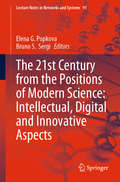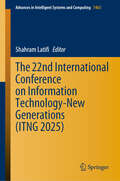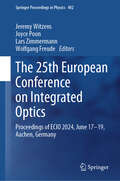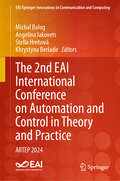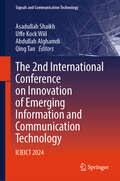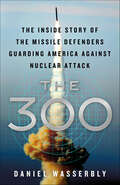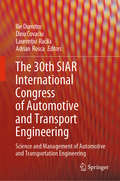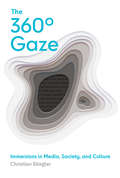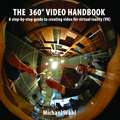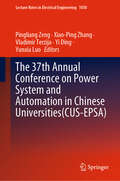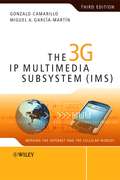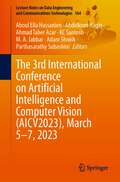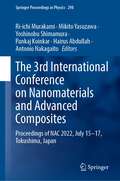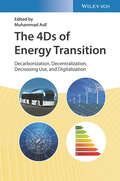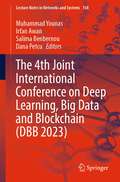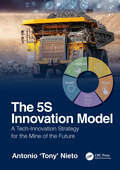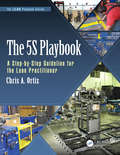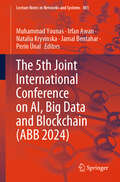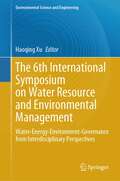- Table View
- List View
The 21st Century from the Positions of Modern Science: Intellectual, Digital and Innovative Aspects (Lecture Notes in Networks and Systems #91)
by Elena G. Popkova Bruno S. SergiThese proceedings gather the best papers presented at the “10th International Scientific and Practical Conference – the 21st Century from the Positions of Modern Science: Intellectual, Digital and Innovative Aspects,” which was organized by the non-profit organization “Institute of Scientific Communications.” The conference took place on May 23–24 in Nizhny Novgorod, Russia, with support from Minin Nizhny Novgorod State Pedagogical University. The chief advantage of these proceedings are their multidisciplinary character – they include articles and empirical studies addressing various fields, including economics, the social sciences, and law. Accordingly, the target audience is broad, covering scholars, researchers, independent experts, entrepreneurs, and government workers, who are interested in issues concerning: measuring and accelerating socio-economic development; the formation and evolution of the digital society and digital economy; the role of economic systems and economic subjects in the 21st-century technological revolution (the fourth industrial revolution); development and implementation of AI; development and application of intellectual resources in economic activities; and innovations in the economy.
The 22nd International Conference on Information Technology-New Generations (Advances in Intelligent Systems and Computing #1463)
by Shahram LatifiThis book covers technical contributions that have been submitted, reviewed and presented at the 22nd annual event of International conference on Information Technology: New Generations (ITNG) The applications of advanced information technology to such domains as astronomy, biology, education, geosciences, security and health care are among topics of relevance to ITNG. Visionary ideas, theoretical and experimental results, as well as prototypes, designs, and tools that help the information readily flow to the user are of special interest. Machine Learning, Robotics, High Performance Computing, and Innovative Methods of Computing are examples of related topics.
The 25th European Conference on Integrated Optics: Proceedings of ECIO 2024, June 17–19, Aachen, Germany (Springer Proceedings in Physics #402)
by Jeremy Witzens Joyce Poon Lars Zimmermann Wolfgang FreudeThis volume presents peer-reviewed and selected papers from the 2024 European Conference on Integrated Optics (ECIO), held on 17-19 June, 2024, and organized by RWTH Aachen University, Germany, in collaboration with Max-Planck Institute of Microstructure Physics, Technical University of Berlin, Leibniz Institute for High Performance Microelectronics, and Karlsruhe Institute of Technology. In the 25th edition of this conference, internationally recognized experts share their latest research and showcase their products and services in the field of integrated optics, optoelectronics, and nano-photonics. The conference focuses on leading-edge research and its broad application scope ranges from tele/datacom, optical interconnects, and (bio) optical sensing to more disruptive areas such as quantum computing and programmable photonics.
The 2nd EAI International Conference on Automation and Control in Theory and Practice: ARTEP 2024 (EAI/Springer Innovations in Communication and Computing)
by Michal Balog Angelina Iakovets Stella Hrehová Khrystyna BerladirThis book presents the proceedings of the EAI International Conference on Automation and Control in Theory and Practice (ARTEP 2024), held in Orechová Potôň, Slovakia, February 7-9, 2024. The aim of the conference was to meet the experts in the field of control, industrial automation and ICT in the industry from universities, colleges, and practice. The conference aims to draw attention to modern trends in the field, to enable experts, pedagogues and scientific researchers to present the results achieved in their work, to exchange experiences and establish working contacts between meeting participants. The ARTEP proceedings includes papers on automation and control and their integration of technologies such as Industry 4.0, robotics, and IoT. ARTEP is primarily a conference for scientists and practitioners who develop and study automation, management, and technologies.
The 2nd International Conference on Innovation of Emerging Information and Communication Technology: ICIEICT 2024 (Signals and Communication Technology)
by Uffe Kock Wiil Asadullah Shaikh Abdullah Alghamdi Qing TanThis book presents the proceedings of the 2nd International Conference on Innovation of Emerging Communication and Information Technology (ICIEICT 2024), which took place October 20-23, 2024, in Casablanca, Morroco. The conference is devoted to communication, computer science, electrical and electronics engineering, telecommunication engineering, and information technology. The conference is intended to provide a forum for research scientists, engineers, educators, and practitioners throughout the world to learn, share knowledge, publish, and disseminate the most recent innovations and developments, ideas, and applications in all fields of science, technology and information technology.
The 2nd International Workshop on Learning Technology for Education in Cloud
by Lorna Uden I-Hsien Ting Hsin-Chang Yang Yu-Hui TaoProceedings from the 2013 LTEC conference in Kaohsiung, Taiwan. The papers examine diverse aspects of Learning Technology for Education in Cloud environments, including social, technical and infrastructure implications. Also addressed is the question of how cloud computing can be used to design applications to support real time on demand learning using technologies. The workshop proceedings provide opportunities for delegates to discuss the latest research in TEL (Technology Enhanced Learning) and its impacts for learners and institutions, using cloud technologies.
The 3-D Global Spatial Data Model: Principles and Applications, Second Edition
by Earl F. BurkholderTraditional methods for handling spatial data are encumbered by the assumption of separate origins for horizontal and vertical measurements, but modern measurement systems operate in a 3-D spatial environment. The 3-D Global Spatial Data Model: Principles and Applications, Second Edition maintains a new model for handling digital spatial data, the global spatial data model or GSDM. The GSDM preserves the integrity of three-dimensional spatial data while also providing additional benefits such as simpler equations, worldwide standardization, and the ability to track spatial data accuracy with greater specificity and convenience. This second edition expands to new topics that satisfy a growing need in the GIS, professional surveyor, machine control, and Big Data communities while continuing to embrace the earth center fixed coordinate system as the fundamental point of origin of one, two, and three-dimensional data sets. Ideal for both beginner and advanced levels, this book also provides guidance and insight on how to link to the data collected and stored in legacy systems.
The 300: The Inside Story of the Missile Defenders Guarding America Against Nuclear Attack
by Daniel WasserblyMilitary and security expert Daniel Wasserbly introduces the elite unit tasked with protecting the nation from long-range weapons of mass destruction.Comprised of just three hundred soldiers, the United States Army’s 100th Missile Defense Brigade and 49th Missile Defense Battalion utilize sophisticated and cutting-edge technology to monitor the skies and seas surrounding the country and shield three hundred million Americans against any potential nuclear threat. Named for the number of Spartan warriors who defended Greece at the Battle of Thermopylae, these vigilant individuals endure rigorous, always-evolving regimens to maintain peak efficiency in the event of an actual nuclear strike.Assigned to extraordinary locations at Fort Greely, Alaska and Schriever Air Force Base, Colorado, the 300 are responsible for the highest levels of homeland security. They not only maintain a never-ending watch via radar and sensor arrays, but receive continuous training in operating advanced interceptors designed to home in on and destroy in-flight ballistic missiles. It’s a complex—and occasionally unreliable—defense system that scientists and engineers are always improving and upgrading.With unprecedented access to the highly classified strategic nerve centers of U.S. Northern Command in Cheyenne Mountain, years of research, and dozens of exclusive interviews with normally inaccessible missile crews, Wasserbly reveals the incredible true story behind the 300’s essential defense operations.
The 30th SIAR International Congress of Automotive and Transport Engineering: Science and Management of Automotive and Transportation Engineering
by Ilie Dumitru Dinu Covaciu Laurențiu Racila Adrian RoscaThis proceedings book includes papers that cover the latest developments in automotive vehicles and environment, advanced transport systems and road traffic, heavy and special vehicles, new materials, manufacturing technologies and logistics and advanced engineering methods. Authors of the papers selected for this book are experts from research, industry and universities, coming from different countries. The overall objectives of the presentations are to respond to the major challenges faced by the automotive industry, and to propose potential solutions to problems related to automotive technology, transportation and environment, and road safety.The congress is organized by SIAR (Society of Automotive Engineers from Romania) in cooperation with SAE International. The purpose is to gather members from academia, industry and government and present their possibilities for investigations and research, in order to establish new future collaborations in the automotive engineering and transport domain. This proceedings book is just a part of the outcomes of the congress.The results presented in this proceedings book benefit researchers from academia and research institutes, industry specialists, Ph.D. students and students in Automotive and Transport Engineering programs.
The 360° Gaze: Immersions in Media, Society, and Culture
by Christian StieglerA comprehensive study of the pervasive role of immersion and immersive media in postmodern culture, from a humanities and social sciences perspective.Virtual reality, augmented reality, mixed reality, and other modes of digitally induced immersion herald a major cultural and economic shift in society. Most academic discussions of immersion and immersive media have focused on the technological aspects. In The 360° Gaze, Christian Stiegler takes a humanities and social science approach, emphasizing the human implications of immersive media in postmodern culture. Examining characteristics common to all immersive experiences, he uncovers dominant metaphors, such as the rabbit hole, and prevailing ideologies. He raises fundamental questions about opportunities and risks associated with immersion, as well as the potential effects on individuals, communities, and societies.
The 360° Video Handbook: A Step-by-step Guide to Creating Video for Virtual Reality (VR)
by Michael WohlA practical hands-on guidebook for producers, directors, cinematographers, sound recordists, and editors interested in creating 360-degree video. Coursing an easy-to-follow trail through the thicket of technobabble and jargon, The book provides nuts-and-bolts recommendations on everything from the selection of cameras, microphones and editing tools to aesthetic and creative decisions such as camera placement and blocking, as well as editing, incorporating titles, transitions, andother effects.
The 37th Annual Conference on Power System and Automation in Chinese Universities (Lecture Notes in Electrical Engineering #1030)
by Xiao-Ping Zhang Yi Ding Pingliang Zeng Vladimir Terzija Yunxia LuoThis book includes original, peer-reviewed research papers from the 37th Annual Conference of Power System and Automation in Chinese Universities (CUS-EPSA), held in Hangzhou, China on October 23-25, 2022. These papers cover topics as Evolution and development path of the power system, Resilience assessment, analysis and planning of power system, Power system planning and reliability, Modelling and simulation of novel power system, Power electronic for power system stability analysis, Power system relay protection and automation and so on. The papers included in this proceedings share the latest research results and practical application examples on the methodologies and algorithms in these areas, which makes the book a valuable reference for researchers, engineers, and university students.
The 37th Parallel: The Secret Truth Behind America's UFO Highway
by Ben MezrichThis real-life The X-Files and Close Encounters of the Third Kind tells the true story of a computer programmer who tracks paranormal events along a 3,000-mile stretch through the heart of America and is drawn deeper and deeper into a vast conspiracy.Like "Agent Mulder" of The X-Files, computer programmer and sheriff's deputy Zukowski is obsessed with tracking down UFO reports in Colorado. He would take the family with him on weekend trips to look for evidence of aliens. But this innocent hobby takes on a sinister urgency when Zukowski learns of mutilated livestock, and sees the bodies of dead horses and cattle--whose exsanguination is inexplicable by any known human or animal means. Along an expanse of land stretching across the southern borders of Utah, Colorado, and Kansas, Zukowski discovers multiple bizarre incidences of mutilations, and suddenly realizes that they cluster around the 37th Parallel or "UFO Highway." So begins an extraordinary and fascinating journey from El Paso and Rush, Colorado, to a mysterious space studies company and MUFON, from Roswell and Area 51 to the Pentagon and beyond; to underground secret military caverns and Indian sacred sites; beneath strange, unexplained lights in the sky and into corporations that obstruct and try to take over investigations. Inspiring and terrifying, this true story will keep you up at night, staring at the sky, and wondering if we really are alone...and what could happen next.
The 3G IP Multimedia Subsystem (IMS)
by Gonzalo Camarillo Miguel-Angel García-MartínThird edition of this best-selling guide to IMS: fully revised, and updated with brand new materialThe IMS (IP Multimedia Subsystem) is the technology that merges the Internet with the cellular world. It makes Internet technologies such as the web, email, instant messaging, presence, and videoconferencing available nearly everywhere at any time.The third edition of this bestselling book is fully updated and provides comprehensively expanded content, including new chapters on emergency calls and on Voice Call Continuity (VCC). As well as this, The 3G IP Multimedia Subsystem (IMS) presents updated material including a comprehensive picture of Session Initiation Protocol (SIP) as well as its applicability to IMS. As most of the protocols have been designed in the IETF, this book explains how the IETF developed these protocols and describes how these protocols are used in the IMS architecture.This is an indispensable guide for engineers, programmers, business managers, marketing representatives and technically aware users who want to understand how the IMS works and explore the business model behind it.New chapters on emergency calls, Voice Call Continuity (VCC), service configuration (XCAP, XDM), and conferencingFully updated throughout, including Policy and Charging Control (PCC), QoS, Presence, Instant Messaging, Multimedia Telephony Services, and Push-to-talk over Cellular (PoC)Describes the IP Multimedia Subsystem from two different perspectives: from the IETF perspective, and from the 3GPP perspective.Provides details on the latest policy technology and security architectureWritten by experienced professionals in the field.
The 3rd International Conference on Artificial Intelligence and Computer Vision (Lecture Notes on Data Engineering and Communications Technologies #164)
by Ahmad Taher Azar Aboul Ella Hassanien Abdelkrim Haqiq M. A. Jabbar Parthasarathy Subashini Kc Santosh Adam SłowikThis book presents the proceedings of the 3rd International Conference on Artificial Intelligence and Computer Vision (AICV’2023) which will be held in Marrakesh, Morocco, during March 05–07, 2023. This international conference, which highlighted essential research and developments in the fields of artificial intelligence and computer visions, was organized by the computer, Networks, Mobility and Modeling Laboratory (IR2M), Faculty of Sciences and Techniques, Hassan First University, Settat, Morocco, the Scientific Research Group in Egypt (SRGE), Cairo University, and the Automated Systems & Soft Computing Lab (ASSCL), Prince Sultan University, Riyadh, Saudi Arabia. The book is divided into sections, covering the following topics: swarm-based optimization mining and data analysis, deep learning and applications, machine learning and applications, image processing and computer vision, sentiment analysis, and recommendation systems, and software-defined network and telecommunication.
The 3rd International Conference on Nanomaterials and Advanced Composites: Proceedings of NAC 2022, July 15-17, Tokushima, Japan (Springer Proceedings in Physics #298)
by Ri-Ichi Murakami Hairus Abdullah Mikito Yasuzawa Yoshinobu Shimamura Pankaj Koinkar Antonio NakagaitoThis book presents selected articles from the 3rd International Conference on Nanomaterials and Advanced Composites (NAC 2022) held at Tokushima University in Japan. This event brought together leading researchers and professionals from academia and industry to present their latest findings and served as a platform for the exchange of ideas aiming for further collaborations. Participants from over six countries shared their most up-to-date knowledge in their respective fields covering nanotechnology, nanomaterials, and advanced composites. Even though this conference had both on-site and remotely connected attendees, the main purpose to promote the networking among academics, engineers, and students was fully achieved. This book is part of the effort to disseminate the knowledge gathered during this meeting. The collection of articles covers topics on advanced composites, nanomaterials, ecological materials, energy, microfluidics, crystal growth, and photocatalysis. This representative account of the conference is intended to provide new and useful insights for prospective studies in materials science and engineering.
The 4Ds of Energy Transition: Decarbonization, Decentralization, Decreasing Use, and Digitalization
by Muhammad AsifThe 4Ds of Energy Transition Enables readers to understand technology-driven approaches that address the challenges of today’s energy scenario and the shift towards sustainable energy transition This book provides a comprehensive account of the characteristics of energy transition, covering the latest advancements, trends, and practices around the topic. It charts the path to global energy sustainability based on existing technology by focusing on the four dynamic approaches of decarbonization, decreasing use, decentralization, and digitalization, plus the important technical, economic, social and policy perspectives surrounding those approaches. Each technology is demonstrated with an introduction and a set of specific chapters. The work appropriately incorporates up-to-date data, case studies, and comparative assessments to further aid in reader comprehension. Sample topics discussed within the work by key thinkers and researchers in the broader fields of energy include: Renewable energy and sustainable energy future Decarbonization in energy sector Hydrogen and fuel cells Electric mobility and sustainable transportation Energy conservation and management Distributed and off-grid generation, energy storage, and batteries Digitalization in energy sector; smart meters, smart grids, blockchain This book is an ideal professional resource for engineers, academics, and policy makers working in areas related to the development of energy solutions.
The 4th Joint International Conference on Deep Learning, Big Data and Blockchain (Lecture Notes in Networks and Systems #768)
by Muhammad Younas Irfan Awan Dana Petcu Salima BenbernouThis book constitutes refereed articles which present research work on new and emerging topics such as distributed ledger technology, blockchains and architectures, smart cities, machine learning and deep learning techniques and application areas such as flight pricing, energy demand and healthcare.The intended readership of the book include researchers, developers and practitioners in the areas of deep learning, big data and blockchains technologies and their applications.
The 5S Innovation Model: A Tech-Innovation Strategy for the Mine of the Future
by Antonio 'Tony' NietoThis book is aimed to help us look into the future of mining by defining ultimate operational conditions that will be present in a typical mining operation regardless of how far in the future. It introduces an innovation strategy designed to identify current and future technologies to achieve specific ultimate operational conditions that will be present in ‘the mine of the future’. The mining innovation strategy presented here is the result of several innovation projects where the author had the opportunity to assist and had successfully implemented it at several mining companies and mining research institutions around the world, including Australia, South Africa, the United States, Canada, Peru, and Mexico. This innovation strategy is designed to be consistent with any type of mining method as well as any commodity being mined, such as metal or nonmetal mining, soft-rock or hard-rock mining, underground or surface mining. The five ultimate mining operational conditions or drivers discussed in this book were carefully defined considering current operational and technology trends, which will keep any mining company competitive during the following decades. The mining innovation strategy thus considers five ultimate operational conditions or drivers (1) Achieving maximum safety, (2) simplifying systems, (3) using smart-intelligent systems, (4) designing stealth operations,and (5) sustainable use of environmental and human resources within the operation. These five innovation drivers are common denominators to any mining method, regardless of their operational nature or commodity being mined either today or in the future. It is thus envisaged that the mining innovation model introduced in this book can serve as an initial guideline for the mining industry to better identify current and future technologies that need to be addressed today.
The 5S Playbook: A Step-by-Step Guideline for the Lean Practitioner (The LEAN Playbook Series)
by Chris A. OrtizThis new book in The LEAN Playbook Series supplies step-by-step guidelines on how to properly implement 5S (Sort, Set in Order, Scrub, Standardize, Sustain) and the visual workplace. This book is ideal for Lean practitioners and facilitators looking for a training tool and a guideline that can be used to facilitate successful 5S kaizen events. This playbook includes color images from actual 5S implementations. In addition to the images, a combination of short paragraphs and bulleted descriptions walk you through each step of effective 5S implementation.
The 5th International Conference on Vibration and Energy Harvesting Applications (Lecture Notes in Mechanical Engineering)
by Lihua Tang Kean Aw Guobiao Hu Junlei WangThis book presents select proceedings of the 5th International Conference on Vibration and Energy Harvesting Applications (VEH 2024). This book covers latest research and technological advances in the field of vibration analysis, energy harvesting, and its applications. Topics covered in the book include innovative research works related to vibration analysis, energy harvesting, their applications, and results on the mechanical design, optimization, dynamics, power management circuits and systems, MEMS technology, nanotechnology, new materials, self-powered IoT applications, and other related areas.. The book can be a valuable reference for researchers and professionals interested in vibration analysis, energy harvesting, its applications, and allied fields.
The 5th Joint International Conference on AI, Big Data and Blockchain (Lecture Notes in Networks and Systems #881)
by Muhammad Younas Irfan Awan Natalia Kryvinska Perin Ünal Jamal BentaharThis book is the 5th Joint International Conference on AI, Big Data and Blockchain (ABB 2024), 19–21 Aug 2024, Vienna, Austria. This book constitutes refereed articles which present research work on timely research themes such as novel AI methods and models, deep learning techniques, data analytics and hidden patterns, security, privacy and trust, blockchain data management, and fraud detection and prevention, among others. The intended readership of the book includes researchers, developers, and practitioners in the areas of AI, big data, blockchain techniques, technologies, and their applications.
The 60-Year Curriculum: New Models for Lifelong Learning in the Digital Economy
by Christopher J. DedeThe 60-Year Curriculum explores models and strategies for lifelong learning in an era of profound economic disruption and reinvention. Over the next half-century, globalization, regional threats to sustainability, climate change, and technologies such as artificial intelligence and data mining will transform our education and workforce sectors. In turn, higher education must shift to offer every student life-wide opportunities for the continuous upskilling they will need to achieve decades of worthwhile employability. This cutting-edge book describes the evolution of new models—covering computer science, inclusive design, critical thinking, civics, and more—by which universities can increase learners’ trajectories across multiple careers from mid-adolescence to retirement. Stakeholders in workforce development, curriculum and instructional design, lifelong learning, and higher and continuing education will find a unique synthesis offering valuable insights and actionable next steps.
The 6th International Conference on Wireless, Intelligent and Distributed Environment for Communication: WIDECOM 2023 (Lecture Notes on Data Engineering and Communications Technologies #185)
by Isaac Woungang Sanjay Kumar DhurandherThis book presents the proceedings of the 6th International Conference on Wireless Intelligent and Distributed Environment for Communication (WIDECOM 2023), which took place at Brock University, St. Catharines, Ontario, Canada, October 11-13, 2023. The book addresses issues related to new dependability paradigms, design, and performance of dependable network computing and mobile systems, as well as issues related to the security of these systems. The goal of the conference is to provide a forum for researchers, students, scientists and engineers working in academia and industry to share their experiences, new ideas and research results in the above-mentioned areas.
The 6th International Symposium on Water Resource and Environmental Management: Water-Energy-Environment-Governance from Interdisciplinary Perspectives (Environmental Science and Engineering)
by Haoqing XuThis book is designed to be the introductory work in the Water-Energy-Environment-Governance from Interdisciplinary Perspectives Series and provides an in-depth look at sustainable development and management in the water sector across. The water-energy-environment nexus (WEEN) represents important interstate connections of water, energy, and the environment. Present day water and energy systems are interdependent. Water is used in all phases of energy production and electricity generation. Energy is required to extract, convey, and deliver water of appropriate quality for diverse human uses and then again to treat waste waters prior to their return to the environment. Security in water, energy, and the environment is associated with human, economic, and environmental sustainability. This interweaving is strengthening under aggregating natural resource scarcity and climate change. This book includes selected papers from the 6th International Symposium on Water Resource and EnvironmentalManagement (WREM 2023) and consists of themes pertaining to water resource and environmental management. It provides readers with comprehensive information, and formulation of solutions leading to a set of Water-Energy-Environment-Governance from Interdisciplinary Perspectives through our forum and the publication of your research. As a reference, it is of interest to students, scientists, engineers, government officials, and water resource managers.
